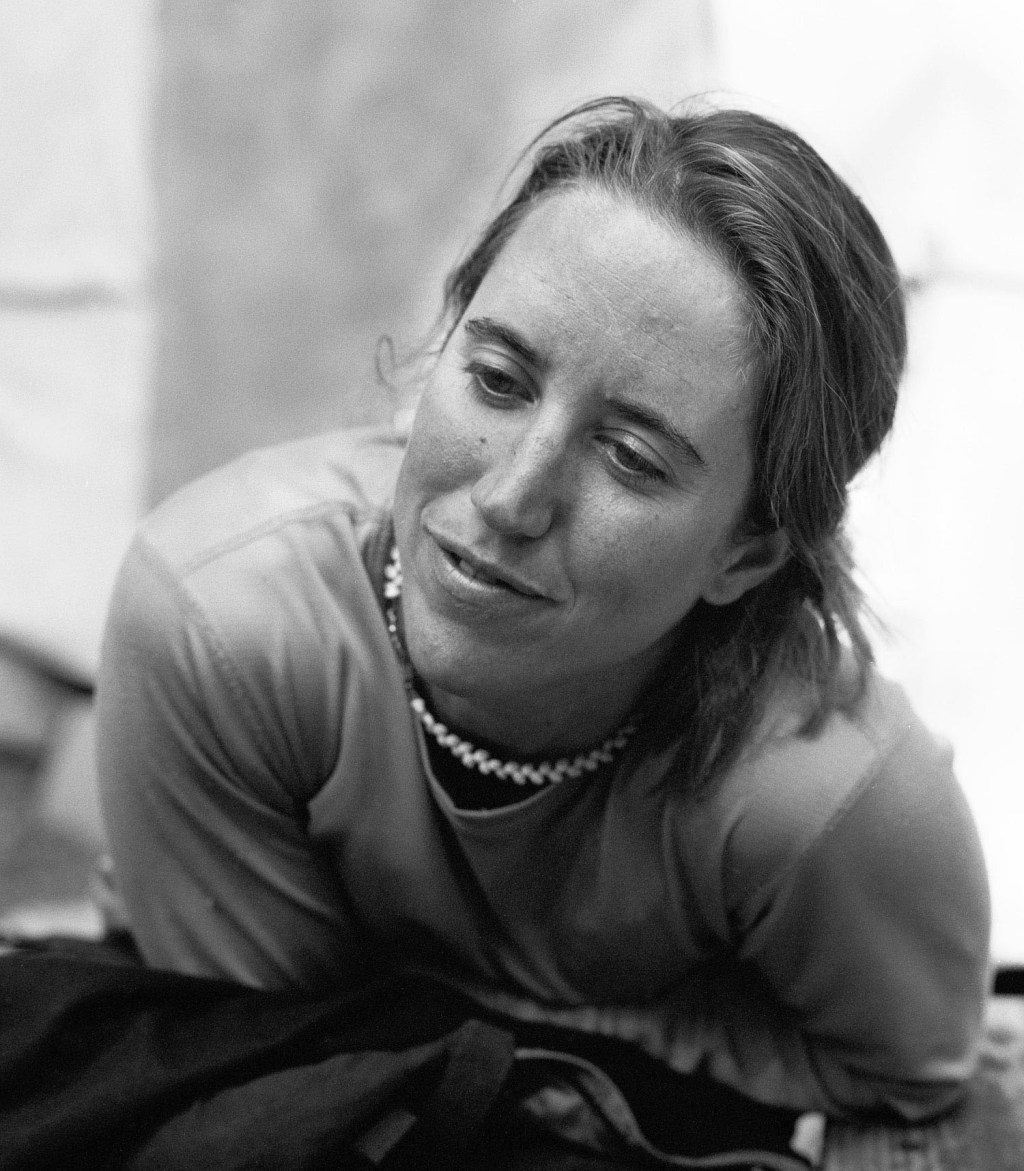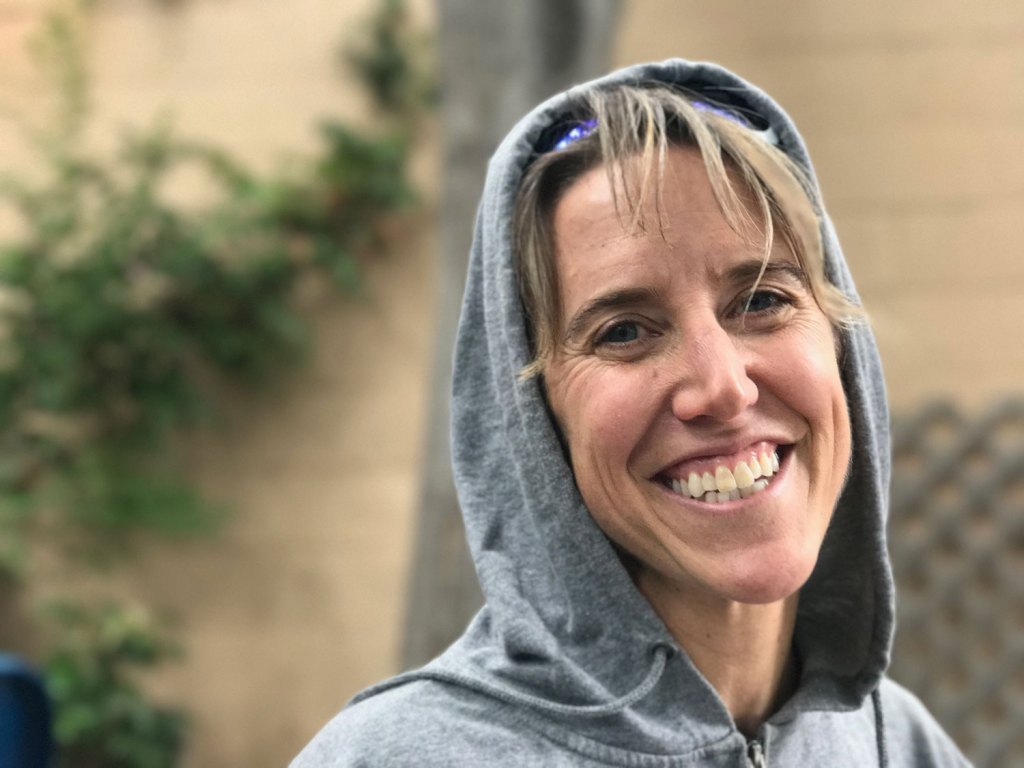It’s an unseasonably cold summer morning in Boulder, Colorado. Heidi Wirtz and I had planned to meet a few hours earlier at 5am to log a full day of cragging on the smooth granite at Castle Rock in Boulder Canyon—2,000 feet in total—but it was pouring rain. Though now it’s cloudy, the rock is still too wet to hold onto and she’s having trouble letting it go. “I just really wanted to go climbing,” she says wistfully between sips of chai while sitting across from me outside Jet’s Espressoria.
To keep warm, she’s dressed in a brown floral skirt matched with a gray cotton sweatshirt, the hood pulled up over her head. Stacks of her business pamphlets are on the steel table next to us. The front of a flyer shows someone on the summit of a narrow tower in the desert Southwest. On the back is a group shot from Cuba.
She tells me that her partner Dale Remsberg wants to climb The Nose with her in less than 24 hours, but she’s not ready right now. The 3,000-foot Nose route on El Capitan in Yosemite National Park is one of the most revered climbs in the world. She rattles off a few reasons, including the fact that her shoulder is weak from a recent surgery, “I can maybe climb 5.12 minus now.”
As we talk, Wirtz emphasizes that it’s important for her to give back to the community after 25 years climbing big walls, exploring the American Southwest and taking off on expeditions to Patagonia, Pakistan, the Middle East and Asia. During these trips, she’s seen how climbing has solidified friendships, helped her grow personally and created lifelong memories. To date, she’s completed about 20 expeditions, including climbing a new route in Argentine Patagonia with Zack Smith. The route required a mix of free and aid climbing, and they topped out in horrendous weather.
“I want to share my mountain knowledge and passion for travel,” she says. That’s why today, she leads climbers as a guide for Jackson Hole Mountain Guides and started Earth Play Retreats in 2014, which allows her to bring groups on climbing, hiking, surfing, whitewater rafting and slacklining adventures around the world for transformative experiences. These getaways provide a venue for people to push themselves mentally and physically in a supportive group. She’s also a yoga instructor and an ambassador and athlete for The North Face.
Childhood: Climbing Streetlight Poles and Developing a Thirst for Adventure
Born in Sacramento, California, Wirtz is the third of four children (she has an older brother and sister, and a half-sister who is nine years younger). When she wasn’t getting into trouble by climbing streetlight poles, Wirtz’s parents frequently took her and her siblings hiking, waterskiing and camping as a kid. Her father put her in snow skis when she was two. In grade school, she began climbing trees in front of her house—she loved being up high and embarking on grand adventures. During one of those outings, when she was around five years old, Wirtz got lost and the police ended up looking for her. She was finally found playing in the gutter with her hunting dog Lucy.
During her youth, Wirtz played soccer and basketball, ran track and was on the high school swim team. In 1990, Wirtz enrolled in Humboldt State University in Northern California, before dropping out a year and a half later to follow the Grateful Dead. She planned to travel with them to Europe, but instead ended up on a road trip that landed her in Crested Butte, Colorado. The town drew her in and she settled there.
To save money for future road trips and to support a newly acquired telemarking habit, Wirtz spent her first winter in Crested Butte in a tent, then spent three subsequent winters in a waterproof teepee located two miles deep in the woods. She picked up one job after another, including shifts as a dishwasher and baker, and later as a manager for the banquet department at the Grande Butte Hotel.

Heidi Wirtz in Yosemite. (Photo Credit: Dean Fidelman)
Beginning in mud season and continuing through the fall, Wirtz would hit the road. During one of her adventures, she hiked the 210-mile John Muir Trail. She also summited Mount Lyell (13,120 feet), Mount Whitney (14,505 feet), Mount Russell (14,094 feet) and Matterhorn Peak (12,280 feet).
Wirtz learned about ice climbing in 1991 when her friends invited her to Colorado’s Black Canyon of the Gunnison National Park—an approximately 2,000-foot-deep, 1,100-foot-wide gorge defined by long routes with few gear options and loose rock, making it a hard and committing trad-climbing area. To access the route, Wirtz and her partner followed a frozen meandering creek. She didn’t own proper ice footwear and instead wore her three-pin telemark boots, which made it hard for her to drive her crampon points into the frozen water. But she didn’t care, “I was like, ‘this the coolest thing ever!’” Wirtz began technical rock climbing a year later.
Early Outings
Wirtz’s first multi-pitch climb involved a 5.8 trad route in Taylor Canyon, south of Gunnison, Colorado. Shortly after that, also in Taylor Canyon, she took her first lead fall when she slipped out of an offwidth (a wide crack requiring specialized technique). Unfamiliar with the skills required, Wirtz bear-hugged the rock for upward progress. Her grip finally gave way and she slid down, cutting the skin on her arms before the rope tightened on her last piece of protection. Though her belayer caught her, “I was terrified because I didn’t know if [climbing] ropes worked,” Wirtz remembers. “I learned from guys that said ‘Never fall.’ It was old school, like our ropes were still made of hemp but they weren’t.” However, she says the fall taught her to trust her gear. After that she returned to the Black Canyon of the Gunnison and climbed a long, complex 5.10 trad route.
A Blue Truck and the Open Road
In the nineties, Wirtz lived seasonally in Crested Butte. In addition to exploring the vast number of hiking trails in the area, she began practicing yoga and went mountain biking. She also climbed every chance she could, and frequented Yosemite and Joshua Tree in California, as well as Indian Creek in Utah. But it wasn’t enough. Finally, Wirtz decided living on the road full-time would be the only way to advance her climbing, so in March 1997 she and her friend Vince Anderson loaded up her 1982 navy blue truck (named Trixie) in Colorado and headed back to the desert.
Exposure Leads to Sponsorship
In 2003, six years after living as a dirtbag on the road, photographer Topher Donahue approached Wirtz and asked to photograph her on a difficult trad route in exchange for a new pair of climbing shoes. Wirtz agreed. “I had holes in my shoes and I was psyched by his offer,” she says.
A few weeks later, Peter Mortimer of Sender Films asked if he could shoot Wirtz on The Wasp for his film Front Range Freaks (2003). He filmed inspiring footage of her climbing hard and, in the process, taking big falls off the 5.12d trad route—back then it was a sandy and rarely attempted line. Mortimer captured her progress and her eventual clean ascent of the route.
Next, her friend and writer Lizzy Scully profiled Wirtz in a story for Rock and Ice magazine on women climbers living on the road. A few months after Front Range Freaks made the rounds and Scully’s story came out, Wirtz attended the biannual Outdoor Retailer show and Wirtz was pulled into meetings with brands that eventually led to athlete contracts.
Wirtz’s first sponsored expedition was to the Bugaboos in British Columbia in 2003, where she and Scully authored Bad Hair Day (5.12) on the 1,800-foot South Howser Minaret. A few years later, while the two were traveling through Pakistan, Scully was injured on a hike when a large boulder she was standing on dislodged. She fell on her chest and face and was too injured to climb. As Scully was recovering from the fall, the two friends spent the remaining weeks of the trip brainstorming what they could do to give back to the world. They decided that they wanted to help promote access to education for girls and came up with a nonprofit that would later become Girls Education International.
In 2004, Wirtz and Vera Shulte-Pelkum broke the women’s speed climbing record on El Cap’s The Nose. During that same week in June, she and Shulte-Pelkum also set the women’s speed climbing records on Yosemite’s Leaning Tower (West Face, 5.7 C2) and Half Dome (Regular Northwest Face 5.9 C1). For the next 10 years, Wirtz undertook several climbing expeditions each year, including climbing a new 1,150-foot route in the Sayan Mountains in Siberia and authoring a 2,500-foot 5.12 route in Taghia, Morocco.
Giving Back to the Climbing Community
In 2014, Wirtz founded Earth Play Retreats, a global adventure travel company with a focus on climbing, yoga, surfing and whitewater rafting. Her goal with the organization is to provide a venue for participants to grow as climbers, safely learn new outdoor skills, and develop a deeper connection with nature. For Wirtz, the trips offer a chance to keep traveling and to stay in touch with what she knows and loves—being in the mountains with incredible people.
In addition to organizing and promoting her upcoming trips, she’s studying the American Mountain Guides curriculum to broaden her rock-guiding skills so she can take clients on more complex outings.

Photo Credit: Chris Van Leuven
This year, Wirtz is also organizing a women’s empowerment climbing festival in Colorado’s Front Range scheduled for spring 2019. The festival will feature clinics led predominantly by women climbers. Instruction and nature therapy clinics will be offered to both women and men. Emphasis will be placed on bridging the gender gap.
Wirtz believes that in recent years, there’s been a loss of mentorship in her climbing community and she hopes that this event will help bring groups together, and also promote future climbing partnerships. A friend recently suggested that Wirtz make it a women’s festival. “I think both women and men have their place in climbing,” Wirtz says, “and I want to bring them together and have them build each other up.”
What’s next for Wirtz? In mid-July, she’s headed to France and Italy to climb 4,000-foot alpine rock routes and summit the Matterhorn.
